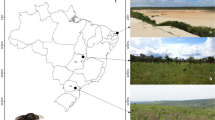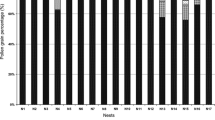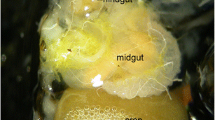Abstract
Ptilothrix plumata is a solitary bee, oligolectic on Malvaceae. In this study we evaluate its oligoletic behavior through quantitative and qualitative analyses of larval provisioning in the National Park of Catimbau, Brazil. Quantitative pollen analysis showed that, to feed one larva, females collect pollen from an average of 17.2 flowers of Pavonia cancellata, 8.5 flowers of P. varians, 4.8 flowers of P. humifusa and 12.4 flowers of Sida galheirensis. Preference for pollen of Pavonia seems to be characteristic for the species and is even more accentuated when considering the volumes of the very large Pavonia pollen grains in the pollen mass: more than 90% of total pollen volume of larval food was from Pavonia species. Comparison to food preferences of P. plumata at other sites shows that the degree of specialization also depends on the composition of plant species at a given locality and a local seemingly monolectic relationship may result from missing opportunities for choice.
Zusammenfassung
Ptilothrix plumata (Apidae, Emphorini) ist eine für Malvaceen oligolektische solitäre Biene, die im Boden in dichten Nestaggregationen nistet (Abb. 1a, b). In dieser Studie beschreiben wir das Nistverhalten von P. plumata und untersuchten ihre Beziehung zu Malvaceen-Blüten im Nationalpark von Catimbau im semiariden Nordosten Brasiliens, wo mehrere Arten dieser Familie vorkommen. Im allgemeinen enthielt jedes Nest eine einzelne Brutzelle, die 3 cm unter der Bodenoberfläche angelegt war. Die Weibchen sammelten Wasser, um den Boden aufzuweichen und das Nest zu bauen. Sie führten bis zu 24 Pollensammelflüge durch, um eine Brutzelle zu verproviantieren. (Abb. 1c–e). Im Proviant der Larven fanden wir Pollen von insgesamt sieben Malvaceen-Arten, wobei durchschnittlich 61% von 3 Pavonia-Arten stammten, während der Rest zwei Sida- und einer Herissantia-Art, sowie einer nichtidentifizierten Malvaceen-Art zugeordnet werden konnte (Abb. 1f). Der Pollenanteil von Nicht-Malvaceen belief sich auf weniger als 6 % (Tab. II). Quantitative Pollenanalysen zeigten, dass die Weibchen durchschnittlich an 17,2 Blüten von Pavonia cancellata, an 8,5 Blüten von P. varians, an 4,8 Blüten von P. humifusa und an 12,4 Blüten von Sida galheirensis Pollen sammelten, um eine Larve zu versorgen (Tab. I und III). Die von den 13 Weibchen am Untersuchungsort angelegten Pollenvorräte zeigten jedoch eine erhebliche Variation in den relativen Anteilen der Pollenkörner der mellitophilen Malvaceen-Arten (Tab. II). Dies könnte auf individuelle Unterschiede innerhalb der Weibchen dieser lokalen Bienenpopulation zurückzuführen sein. Eine generelle Präferenz für Pavonia-Pollen scheint jedoch für die Art charakteristisch zu sein und ist umso deutlicher, wenn das Volumen der sehr grossen Pavonia-Pollenkörner in dem Pollenball in Betracht gezogen wird: mehr als 90% des gesamten Pollenvolumens im Larvenfutter war von Pavonia-Arten und weniger als 1% des Pollenvolumens war von Nicht-Malvaceen (Abb. 4). Wir diskutieren die offensichtlich enge Oligolektie von Ptilothrix plumata für Pavonia-Blüten. Der Vergleich der Sammelpräferenzen einer Population an einem Standort mit nur einer Pavonia-Art zeigt, dass der Grad der Pollenspezialisierung auch von der Zusammensetzung der Planzenarten an einer gegebenen Lokalität abhängt, und dass eine lokal monolektische Beziehung auf fehlenden Auswahlmöglichkeiten beruhen kann.
Similar content being viewed by others
References
Butler G.D. (1967) Biological observations on Ptilothrix sumichrasti (Cresson) in southern Arizona, Pan-Pac. Entomol. 43, 8–14.
Cane J.H., Sipes S. (2006) Characterizing floral specialization by bees: analytical methods and a revised lexicon for oligolecty, in: Waser N.M., Ollerton J. (Eds.), Plant-pollinator interactions: from specialization to generalization, The University of Chicago Press, Chicago, pp. 99–122.
Dötterl S., Füssel U., Jürgens A., Aas G. (2005) 1,4-Dimethoxybenzene, a floral scent compound in willows that attracts an oligolectic bee, J. Chem. Ecol. 31, 2993–2998.
Erdtman G. (1952) Pollen morphology and plant taxonomy. Angiosperms, Chronica Botanica Co., Waltham, Mass, New York.
Füssel U., Dötterl S., Jürgens A., Aas G. (2007) Inter and intraspecific variation in floral scent in the genus Salix and its implication for pollination, J. Chem. Ecol. 33, 749–765.
Gimenes M. (1991) Some morphological adaptations in bees (Hymenoptera, Apoidea) for collecting pollen from Ludwigia elegans (Onagraceae), Rev. Bras. Entomol. 35, 413–422.
Larsson M., Franzén M. (2007) Critical resource levels of pollen for the declining bee Andrena hattorfiana (Hymenoptera, Andrenidae), Biol. Conserv. 134, 405–414.
Linsley E.G., MacSwain J.W., Smith R.F. (1956) Biological observations on Ptilothrix sumichrasti (Cresson) and some related groups of emphorine bees, Bull. Southern Cal. Acad. Sci. 55, 83–101.
Louveaux J., Maurizio A., Vorwohl G. (1978) Methods of melissopalynology, Bee World 59, 139–157.
Martins R.P., Guimarães F.G., Dias C.M. (1996) Nesting biology of Ptilothrix plumata Smith, with a comparison to other species in the genus (Hymenoptera: Anthophoridae), J. Kansas Entomol. Soc. 69, 9–16.
Martins C.F., Zanella F.C.V., Schlindwein C., Camarotti M.F., Melo R.R. (in press) Diagnóstico dos polinizadores do algodoeiro, in: Oliveira P.E., Gaglianone M.C., Gribel R. (Eds.), Uso sustentável e restauração da diversidade de polinizadores autóctones na agricultura e nos ecossistemas relacionados, Ministério do Meio Ambiente/GEF, MMA, Brazil.
Michener C.D. (2007) The bees of the world, second edition, The John Hopkins University Press, Baltimore.
Minckley R.L., Roulston T.H. (2006) Incidental mutualisms and pollen specialization among bees, in: Waser N.M., Ollerton J. (Eds.), Plant-pollinator interactions: from specialization to generalization. The University of Chicago Press, Chicago, pp. 69–98.
Müller A., Diener S., Schnyder S., Stutz K., Sedivy C., Dorn S. (2006) Quantitative pollen requirements of solitary bees: implications for bee conservation and the evolution of bee-flower relationships, Biol. Conserv. 130, 604–615.
Neff J.L., Simpson B.B. (1992) Partial bivoltinism in a ground-nesting bee: the biology of Diadasia rinconis in Texas (Hymenoptera, Anthophoridae) J. Kansas Entomol. Soc. 65, 377–392.
Neff J.L., Simpson B.B., Dorr L.J. (1982) The nesting biology of Diadasia afflicta Cress. (Hymenoptera: Anthophoridae), J. Kansas Entomol. Soc. 55, 499–518.
PARNA (2002) Projeto técnico para a criação do Parque Nacional do Catimbau/PE. Sociedade Nordestina de Ecologia. Contrato n∘ 086-00/02, Proposta para criação do Parque Nacional do Catimbau/PE.
Robertson C. (1925) Heterotropic bees, Ecology 6, 412–436.
Roubik D.W., Moreno J.E. (1991) Pollen and Spores of Barro Colorado Island, Missouri Botanical Garden, 268 p.
Rust R.W. (1980) The biology of Ptilothrix bombiformis (Hymenoptera: Anthophoridae), J. Kansas Entomol. Soc. 53, 427–436.
Schlindwein C. (1998) Frequent oligolecty characterizing a diverse bee-plant community in a xerophytic bushland of subtropical Brazil, Stud. Neotrop. Fauna E. 33, 46–59.
Schlindwein C. (2000) Verhaltensanpassungen oligolektischer Bienen an synchrone und an kontinuierliche Pollenpräsentation, in: Breckle S.W., Schweizer B., Arndt U. (Eds.), Results of worldwide ecological studies, Verlag Günter Heimbach, Stuttgart, pp. 235–250.
Schlindwein C. (2004) Are oligolectic bees always the most effective pollinators?, in: Freitas B.M., Pereira J.O.P. (Eds.), Solitary bees. Conservation, rearing and management for pollination, Imprensa Universitária, Fortaleza, pp. 231–240.
Schlindwein C., Wittmann D. (1997) Stamen movements in flowers of Opuntia (Cactaceae) favour oligolectic bee pollinators, Plant Syst. Evol. 204, 179–193.
Schlindwein C., Martins C.F. (2000) Competition between the oligolectic bee Ptilothrix plumata (Anthophoridae) and the flower closing beetle Pristimerus calcaratus (Curculionidae) for floral resources of Pavonia cancellata (Malvaceae), Plant Syst. Evol. 224, 183–194.
Schlindwein C., Martins C.F. (2004) Nest construction and brood cell provisioning in the ground nesting bee Ptilothrix plumata (Apidae, Emphorini), Proceeding of the 8th IBRA International Conference on Tropical Bees and VI Encontro sobre abelhas, USP, Ribeirão Preto, pp. 86–92.
Schlindwein C., Wittmann D., Martins C.F., Hamm A., Siqueira J.A., Schiffler D., Machado I.C. (2005) Pollination of Campanula rapunculus L. (Campanulaceae): How much pollen flows into pollination and into reproduction of oligolectic pollinators? Plant. Syst. Evol. 250, 147–156.
Silveira F.A., Melo G.A.R., Almeida E.A.B. (2002) Abelhas brasileiras: sistemática e identificação, Ed. IDMAR, Belo Horizonte.
Sipes S.D., Tepedino V.J. (2005) Pollen-host specificity and evolutionary patterns of host switching in a clade of specialist bees (Apoidea: Diadasia), Biol. J. Linn. Soc. 86, 487–505.
Author information
Authors and Affiliations
Corresponding author
Additional information
Manuscript editor: Jean-Noël Tasei
Rights and permissions
About this article
Cite this article
Schlindwein, C., Pick, R.A. & Martins, C.F. Evaluation of oligolecty in the Brazilian bee Ptilothrix plumata (Hymenoptera, Apidae, Emphorini). Apidologie 40, 106–116 (2009). https://doi.org/10.1051/apido/2008067
Received:
Revised:
Accepted:
Issue Date:
DOI: https://doi.org/10.1051/apido/2008067




